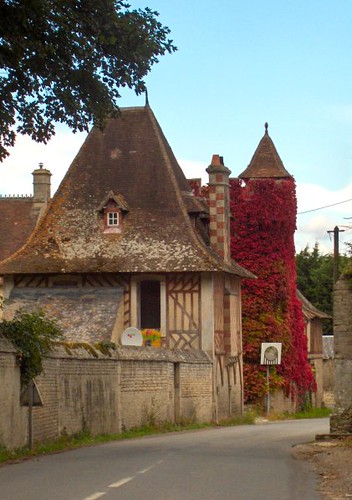 |
Once we had negotiated the nightmarish roadway tangle of Louviers, we found the road to Connelles, which was closed off for construction, leaving us clueless and stranded. Fortunately, two gentlemen strolled by and pointed to a tiny, one-lane road that looked more like a driveway, urging us to take it. We found ourselves winding through medieval-looking clusters of homes that are built right up against the curbs.
Cars raced towards us through these narrow streets at frightening speeds, forcing us right to the edge of the pavement as they shot by, our side view mirrors missing by a fraction of an inch.
My wife served as the navigator, reading the directions to me from the resort printout. As we crept through the town of Connelles, we came to a sign for a restaurant. She read the directions that said, "… the Manoir des Deux Amants is located 300 m. past the Moulin de Connelles restaurant…" Dutifully, she reported to me, "We're almost there. The hotel is only 300 milligrams past this restaurant." I laughed so hard, I almost slammed into the curb.
Finally, we arrived and checked in. The building is a renovated older structure, right on the Seine (actually it's on a small ox-bow channel about 200 feet (that's 80 milligrams) from the main channel of the Seine). There was a little footbridge that crossed the channel to a small park that bordered on the Seine. We had two bedrooms, one bath, a small kitchen (including a dishwasher and a washer/dryer combo), a small living space with a dining table and a balcony overlooking the water.
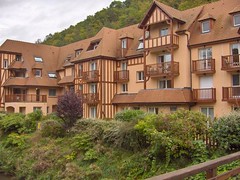 |  |
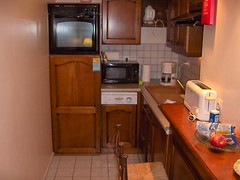 |
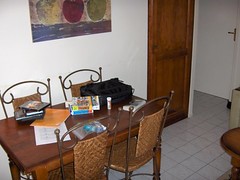 | The staff was courteous and helpful, especially a girl named Gipsy (the resident shopping expert), and a man named Jean-Christophe. |
Whenever I would ask Jean-Christophe for a weather forecast, he would step outside, sniff the air, and tell me, "Cloudy, weez some sun. Maybe rain in zee afternoon." He never used the computer, and he was always right.
We were only given one key to our rooms, and if you were inside, you had to lock the door with the key. This meant that if there was a fire, you would have to find the key to let yourself out.
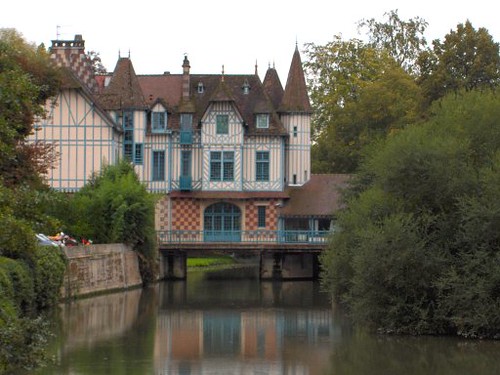
Just 300 milligrams from our hotel was the Moulin de Connelles restaurant, which is in a beautiful converted mill building that straddles the channel. Many old mill buildings in the Seine river valley have been converted in this manner. We couldn't afford to eat there.
The Normandy region is easily accessible by car ferry from various ports in England, so there are lots of British tourists. Our resort was packed with them. It was weird to see so many cars with right-hand drive on the roads and in parking lots.
There was no grocery store of any kind in Connelles, so we had to drive to a town called Val de Reuil. This is easy to pronounce if you say the word "Roy" while gagging on an oyster.
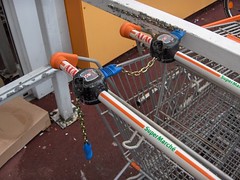 | The "Atac Supermarche" in Val de Reuil was a typical supermarket, except for some peculiar differences from American supermarkets. |
For example, they charge you a one-Euro ransom for shopping carts. The shopping carts are locked together in a daisy-chain arrangement. To take a cart, you have to insert a one-Euro coin (worth about a buck and a quarter) in the canister on the cart, and the chain from the next cart releases your cart. When you finish with the cart, you plug the chain back in, and the coin pops out. So they don't have to send employees out to the lot to gather up the carts.
There was a Halal section for Islamic shoppers (they have a large Islamic population in France). The cheese section was the size of an aircraft carrier. The wine section was huge, and you could buy a bottle of delicious French wine for a dollar. The most expensive bottle we saw was about 7 dollars. Strangely, crackers and salad dressings were nearly absent. And in France, you must bring your own shopping bags- they don't provide them.
When we came to the massive cheese section, we agreed that we would each pick one cheese to take home that day. My daughter informed us that she didn't want anything "runny" or "with mold in it." She looked around for a minute and came up with a wedge of Mimolette. FLASHBACK: About 20 years ago, my sister went to France for a semester abroad program. I picked her up at the airport on her return, and she had a ball of cheese the size of her head that she claimed was the most delicious cheese she had ever tasted. It was Mimolette. So out of the 200 or so varieties of cheese available in France, both my sister and my daughter picked the same one. In fact, she refused to eat any other kind of cheese for the duration of the trip, especially the gooey, moldy the Roquefort I purchased.
 | 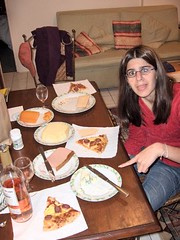 |

No comments:
Post a Comment